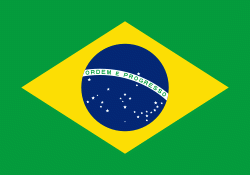São Gonçalo do Pará (São Gonçalo do Pará)
São Gonçalo do Pará is a municipality in the center-west of Minas Gerais state, Brazil. The estimated population in 2020 was 12,597 inhabitants. The total area of the municipality is 265 sqkm and the elevation is 750 m. It is located at 129 km from state capital Belo Horizonte. São Gonçalo do Pará is the seat of the Regional Administration of the Upper São Francisco River.
The creation of the town of São Gonçalo of Pará is closely linked to the revolutionary revolts carried out by miners of the Captainship of Minas Gerais, in 1717. Filipe de Freitas Mourão, was a Portuguese gold prospector who worked in the Pitangui mines in the colonial time. He was involved in revolutionary movements against the collection of taxes on gold, which led him to run away together with its wife, Estefânia de Mourão Bravo. They escaped to the region of the spring of the River Pará where they found other Portuguese who had escaped from Vila Rica (Pero Gonçalves de Amaranto and Estácio Campos de Borgonha).
The Portuguese hired Filipe de Freitas as an overseer of slaves. He gave orders in the informal mines and in the plantation, and he went out looking for gold. Accompanied by slaves, he explored some land next to river Pará, and found a stream with banks suitable for plantations. They called the place "Ribeirão dos Morais" (i.e. the Morais stream). They built farms of wattle and daub. Once the construction was finished, they moved there on 18 December 1723. They placed the image of the Saint Gonçalo of the Amarante in a newly built chapel. They had carried the saint's image with them. The Portuguese had a great devotion to this saint.
Filipe continued to explore, travelling with slaves, and found an area rich hardwood. In this place, he would start the primitive settling, which would later become São Gonçalo of Pará. In 1735, they finished all the construction, including a chapel with the image of São Gonçalo of the Amarante. There was an idea of calling this place "Pará Acima". Filipe de Freitas affirmed he had stopped in that place, close to the banks of River Pará, when he came from Pitangui. The town would hence be named Paragem do Pará (Stop of Pará), in 7 September 1735.
From 1751 to 1755, a new church was built in the same place of the old chapel, in baroque style. In 1750 the name of the town changed to São Gonçalo of Pará, alluding to the River Pará, which had brought the founders, and borders still today the current city. In 1870, the town of São Gonçalo of Pará became part of the district of Pitangui and was annexed to the village Vila de Nossa Senhora da Piedade (presently Pará de Minas).
The town became politically emancipated on 1 January 1949.
The creation of the town of São Gonçalo of Pará is closely linked to the revolutionary revolts carried out by miners of the Captainship of Minas Gerais, in 1717. Filipe de Freitas Mourão, was a Portuguese gold prospector who worked in the Pitangui mines in the colonial time. He was involved in revolutionary movements against the collection of taxes on gold, which led him to run away together with its wife, Estefânia de Mourão Bravo. They escaped to the region of the spring of the River Pará where they found other Portuguese who had escaped from Vila Rica (Pero Gonçalves de Amaranto and Estácio Campos de Borgonha).
The Portuguese hired Filipe de Freitas as an overseer of slaves. He gave orders in the informal mines and in the plantation, and he went out looking for gold. Accompanied by slaves, he explored some land next to river Pará, and found a stream with banks suitable for plantations. They called the place "Ribeirão dos Morais" (i.e. the Morais stream). They built farms of wattle and daub. Once the construction was finished, they moved there on 18 December 1723. They placed the image of the Saint Gonçalo of the Amarante in a newly built chapel. They had carried the saint's image with them. The Portuguese had a great devotion to this saint.
Filipe continued to explore, travelling with slaves, and found an area rich hardwood. In this place, he would start the primitive settling, which would later become São Gonçalo of Pará. In 1735, they finished all the construction, including a chapel with the image of São Gonçalo of the Amarante. There was an idea of calling this place "Pará Acima". Filipe de Freitas affirmed he had stopped in that place, close to the banks of River Pará, when he came from Pitangui. The town would hence be named Paragem do Pará (Stop of Pará), in 7 September 1735.
From 1751 to 1755, a new church was built in the same place of the old chapel, in baroque style. In 1750 the name of the town changed to São Gonçalo of Pará, alluding to the River Pará, which had brought the founders, and borders still today the current city. In 1870, the town of São Gonçalo of Pará became part of the district of Pitangui and was annexed to the village Vila de Nossa Senhora da Piedade (presently Pará de Minas).
The town became politically emancipated on 1 January 1949.
Map - São Gonçalo do Pará (São Gonçalo do Pará)
Map
Country - Brazil
Currency / Language
| ISO | Currency | Symbol | Significant figures |
|---|---|---|---|
| BRL | Brazilian real | R$ | 2 |
| ISO | Language |
|---|---|
| EN | English language |
| FR | French language |
| PT | Portuguese language |
| ES | Spanish language |

















